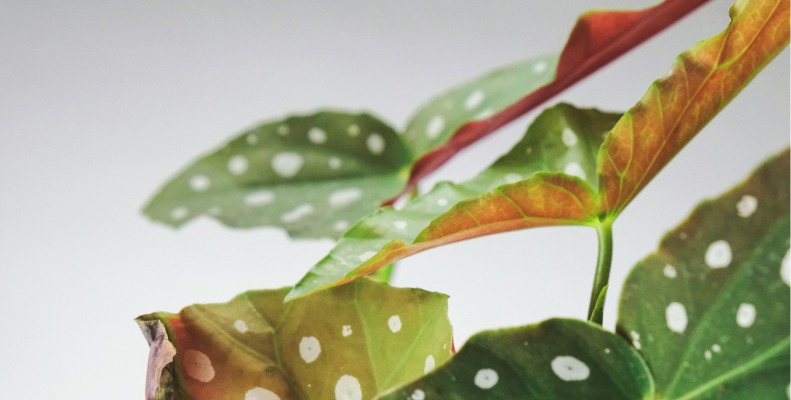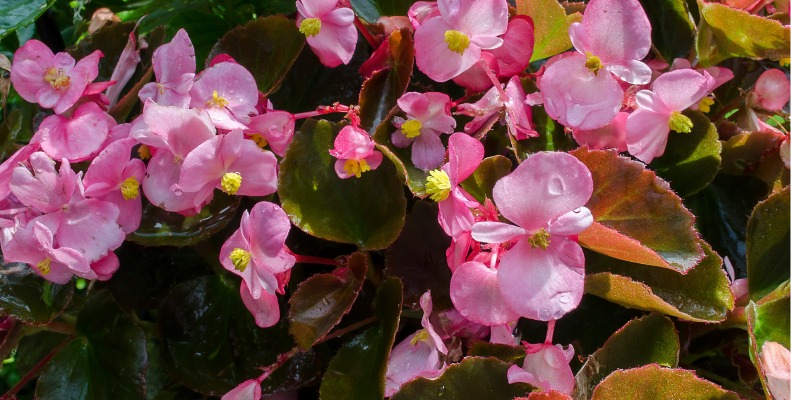Begonias are easy to care for and bloom for a long time. They grow well as indoor plants in cool places. Outdoors, you’ll see them in gardens during the warm months.
They have beautiful flowers and leaves. Landscapers use them a lot in pots outside. Begonias prefer some shade and their soil should be a bit acidic. Some animals might get sick if they eat the roots.
There are over 2000 types of begonias. The many versions you see are because they can mix with each other. This creates even more varieties and colors to enjoy.
Key Takeaways
- Begonias are low-maintenance and provide long-lasting blooms.
- They thrive in partial shade and slightly acidic soil.
- Begonias come in a wide variety of species and cultivars.
- Begonia roots may be toxic to some animals.
- Begonias are commonly used in outdoor container arrangements.
Introduction to Begonias
Begonias are part of a group with over 2,000 different types. This family is so varied because they mix easily, making new kinds. We can split begonias into four groups by the shapes of their roots. There are tuberous, fibrous, hardy, and rhizomatous begonias.
Begonia Varieties
There’s a huge choice of begonias for people who love plants. You can pick from bright, full wax begonias to the fancy, hanging tuberous ones. Each type fits different conditions and looks, making them a great choice for any garden or home.

Growing Conditions
Begonias like places where they’re not in direct sun, like under trees or on a porch. Too much sun might harm their pretty flowers. They need soil that’s full of nutrients and soft.
Keep them in soil that can drain well. This keeps the roots from getting too wet. A good choice is a peat-based mix with lots of organic stuff, like leaf mold.
Toxicity and Safety
Begonias are safe for people, but some pets might not be okay around them. They might cause a rash in those who are very sensitive. Always be careful with any plant around kids and pets.
Begonia Plant Care
Light Requirements
Begonias love partial to full shade, avoiding direct sunlight. Direct sun can make their flowers droop or lose color. Tuberous begonias in pots can handle a bit more sun. Indoors, they thrive in the light that’s filtered.
Fibrous or wax begonias welcome consistent flowering in the shade. If they get too much sun, their petals may wilt or colors fade.
Soil Needs
The best soil for begonias is rich, slightly acidic, and drains well. A mix with lots of organic matter is ideal. A mix for African violets works too.
Watering Begonias
Water your begonia deeply about once every seven days. Let the soil’s top half inch dry out before watering again. Overwatering can cause root rot, so it’s crucial to let them dry between waterings.
Temperature and Humidity
Indoor begonias like moderate temperatures, around 65 to 70 degrees Fahrenheit. They prefer places with some humidity, about 50% or slightly less. If your home tends to be dry, a humidity boost can come from a water saucer or a humidifier.
Fertilizing Begonias
The type of fertilizer needed depends on the begonia type. Rhizomatous begonias indoors do well with a diluted water-soluble fertilizer at half strength. For tuberous begonias, use a 5-1-1 fertilizer like fish emulsion twice a month during the blooming season.
Hardy begonias prefer lighter feeding. Mix diluted fertilizer with compost or peat moss. Apply it carefully as too much can damage the leaves.
Types of Begonias
Begonias have many different types, each with its own unique traits. By learning about these varieties, gardeners can pick the right ones for their space and care abilities.
Wax Begonias
The most common are the wax begonias. They are also known as annual or bedding begonias. These plants love the shade and add lots of color under trees or in planters. They grow 6 to 12 inches in height and width, making them great for annual beds.
Tuberous Begonias
Tuberous begonias have vibrant flowers and are great for hanging baskets. They can also grow in larger containers and reach 12 to 18 inches in height indoors or over 3 feet outdoors.
Cane Begonias
Cane begonias grow upright and have unique segmented stems. Angel wing begonias, known for their leaf shape, are part of this category. They are good for indoor or outdoor growth. Depending on where they are planted, they can range from 6 inches to 5 feet in size.
Rhizomatous Begonias
Rhizomatous begonias have thick stems that grow near the soil surface. They are known for their interesting leaves and are mainly grown indoors. They can be small or up to 3 feet wide and tall.
Rex Begonias
Rex begonias are a type of rhizomatous begonia sold by florists and garden centers. They can grow 12 to 18 inches tall and wide. Their unique foliage makes them a favorite for indoor growing or summer garden beds.
Planting and Repotting Begonias
Wait to move your begonias outside until after the last frost. They don’t like the cold, and even a little frost can hurt them. Cold temperatures under 50 degrees can be damaging.
Planting Location
Choose a spot with partial shade or where the sun is filtered. This place should get sun in the morning but be shady in the afternoon. If you live where it’s really sunny, pick a begonia that can handle more sun, like Surefire Rose. It’s also key that the spot has good air flow to keep powdery mildew away.
How to Plant
Set wax begonias about 6 to 8 inches apart when planting. Make sure you give other types enough space based on how big they will get. You can start begonia tubers inside. Place them, hollow side up, in a tray with moist soil about 1 inch apart. Water them enough to keep the soil moist but not wet. Wait for them to sprout, which should take about 4 weeks, and then move them to a sunny spot. Put them outside only after the frost danger is gone.
Repotting Begonias
Tuberous begonias die back every year, so they need special care. Near late summer or early fall, ease up on the water and cut back the fading leaves. When there’s frost warning, dig up the tubers. Remove any dirt, let them dry on newspaper under the sun for a week. To keep them healthy, lightly dust the tubers with sulfur powder and pack them in paper bags or wrap them. Rhizomatous and wax begonias don’t die back. Give them a light trim or pinch every year to stay healthy and compact.
Pruning and Propagating Begonias
Pruning Begonias
When you trim rhizomatous or wax begonias, always cut neatly and at an angle close to a leaf or flower. Cut away from the node. For young plants, cut them down near the soil, leaving only a leaf or two at the top. This makes them grow bushier.
As plants get older, trim them with a light touch. For cane begonias, nip the top of each stem when they reach 6 inches in height. This makes them grow wider, not taller. Prune back any cane growing much taller than the others.
For rex begonias, they need less pruning. Pinch off the tips of young plants to fill them out. If they get bare or too tall, gently shorten them with angled cuts.
Propagating from Cuttings
To create new begonias, use leaf or stem cuttings. Stick a cutting in water or soil just below a node. You can add a rooting hormone to help it grow. Keep the soil damp until it roots, which usually takes 3 to 4 weeks.
Once it has roots, move it to a larger home carefully.
Propagating from Seeds
Begonia seeds are some of the world’s tiniest, with an ounce holding up to a million. Begin them indoors three months before the last frost. Sow them shallowly in a specified mix for seeds, and keep the mix wet in the shade. After 3 to 4 weeks, little plants will pop up.
After the last frost, move them outdoors to their final place.
Container Growing Begonias
Begonias are great for pots, bringing color to containers. They live for a few years. Plant them after the frost is over.
Choose pots with holes for drainage. Mix potting soil and compost. Put the pot where the begonias will get the right light.
Begonias grow best when their roots are a bit tight. Start in small pots. Move to bigger ones as needed. Use fertilizer monthly.
Let the top of the soil dry out before watering again. In cold places, move begonias inside when it gets under 45 degrees.
Overwintering Begonias
Tuberous Begonia Winter Care
Tuberous begonias are best when watered sparingly in winter. Too much water can harm these plants, causing them to rot. It’s also a good idea to cut back weak growth. Stop watering if you see these signs.
Fibrous Begonia Winter Care
Fibrous begonias prefer staying inside if it gets colder than 60 degrees Fahrenheit. They can live as indoor plants in winter, even though they might lose their leaves.
Conclusion
Begonias bring color to any garden or indoor area. They come in various types like wax, tuberous, and rhizomatous. This means there’s a begonia for every place. Just give them the right amount of light, water, soil, and food. Then, watch as these tropical plants bloom beautifully.
If you love colors, wax begonias and the more showy tuberous ones are for you. They are perfect for both beginners and experts in gardening. With a bit of care, begonias can brighten up your home or garden all year long.
The fun of growing begonias is in how adaptable and pretty they are. Taking good care of them opens up a world of bright colors and interesting shapes.

